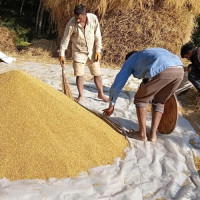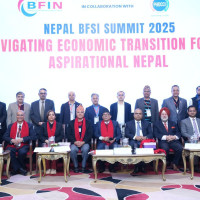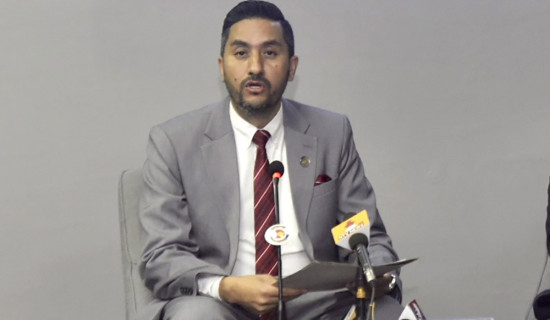- Sunday, 21 December 2025
Electricity access touches 95%
By Laxman Kafle,Kathmandu, Aug. 11: The Nepal Electricity Authority (NEA) has said that 95 per cent of the country's total population has access to electricity.
Speaking at a press conference on Thursday, Managing Director of NEA Kul Man Ghising said about two years ago, 89 per cent of citizens used to get electricity from the national transmission line, but now it has reached 95 per cent.
The Madhes, Bagmati and Gandaki provinces have basically been completely electrified, he said.
Similarly, around 95 per cent electrification has been completed in Koshi Province, 98 per cent in Lumbini Province, 67 per cent in Karnali Province and 82 per cent in Sudurpaschim Province.
Ghising said that out of 753 local levels, 505 have basically been fully electrified with the Authority's system, 227 local levels have been electrified in most places and 21 local levels have been electrified through solar, small and micro hydropower.
All preparations are being completed to implement the government's announcement to electrify the entire country within next two years, he said.
"We are working round the clock to produce adequate power and ensure reliable and qualitative supply of power to the people. Our priority is to increase production, expansion of transmission and distribution lines, reduce leakage, expand access to maximum customers and reduce financial expenses,” he said.
He said that the population had access to electricity connected to the national transmission line. Among them, Madhes Province, Bagmati Province and Gandaki Province have been fully electrified, he said.
After starting his second term in the Authority, he said that since the last two years, he has taken full initiative for the expansion of electricity service to people along with the expansion of transmission and distribution.
With the improvement in electricity services, per capita energy consumption has increased from about 235 units to 380 units in two years, he said.
Ghising said that the Authority has provided subsidies to about 2.2 million customers with free electricity, irrigation, drinking water, religious sites, charging stations at an annual fee of about Rs. 4 billion.
Similarly, the Authority has provided around 40,000 meters free of cost to poor families.
He informed that call centres have been set up and brought into operation in every province to address the complaints of customers in electricity supply.
NEA earns profit of Rs. 12.33 billion
The NEA has earned a net profit of Rs. 12.33 billion in the last fiscal year 2022/23.
According to the unaudited financial statement of the last fiscal year 2022/23, the Authority's profit has reached Rs. 12.33 billion, said Ghising.
In the fiscal year 2021/22, the NEA had earned a net profit of Rs. 13.37 billion. However, the NEA’s profit was limited to Rs. 6.10 billion in the fiscal year 2020/21.
Ghising said that last year, due to the increase in dry season and the reduction in water flow in rivers and canals, power generation of the Authority and private sector hydropower plants decreased and the electricity import increased slightly to meet domestic demand.
According to the NEA, the Authority's income from electricity sales and other sources was about Rs. 81 billion two years ago, but now it has increased to about Rs. 118 billion.
He said that the accumulated profit of the Authority has increased from Rs. 11 billion to Rs. 36.67 billion.
He said that in the last two years, the Authority has invested an amount equal to Rs. 48 billion from its own resources in the expansion and improvement of the transmission and distribution system.
In addition, it has accumulated about Rs. 30 billion in the government's treasury as loan, interest and royalty.
The electricity leakage, which was 17.38 per cent in FY 2020/21, has decreased by 3.92 percentage points to 13.46 per cent at present.
Electricity leakage towards distribution has been limited to 9.76 per cent, said the NEA.
Preparing to issue shares to general public
MD Ghising said that the Authority is preparing to issue shares to the general public.
He said that the NEA has already forwarded the process to issue shares to the general public.
For the first time, Nepal has started exporting 39 MW of electricity to India from November 2021 while currently about 450 MW of electricity is being exported, according to the authority.
About 600 MW capacity additional projects for export to India are in the process of being approved by India's Ministry of Power, Ghising said.
Installed capacity reaches 2,822 MW
So far, the total installed capacity of the electricity system has reached 2,822 MW.
He said that production of 1383.37 megawatts of hydropower and solar projects was started, including 751 megawatts in the fiscal year 2021/22 and 632.37 megawatts in the fiscal year 2022/23.
In the last two years, around 1,246 MW of electricity has been added to the national grid.
Similarly, power purchase agreements have been completed for about 8,052 megawatt so far, and in the last two years only about 1,774 megawatt PPA have been completed, he said.
Apart from this, the Authority has already completed the draft for power purchase and sale agreement of about 2,290 megawatts.
The power purchase agreement of 2,168 MW is in the process of being drafted.
The base price of solar power is Rs. 5.94, and it is in the stage of making a contract for the purchase of about 100 megawatts of solar power by bidding for the first time, he said.
The Authority has said that the process of raising financial resources for investment in the 1060 MW Upper Arun Hydropower Project has reached its final stage.
Likewise, the construction of four hydropower projects of 270 megawatts under construction lead by Chilime Hydropower Project, a subsidiary company of the Authority, has reached its final stage.
Challenging to NEA
Ghising said that the coming days would be more challenging for the Authority to improve the electricity supply.
"The first challenge is to institutionalise the benefits obtained so far, while the second challenge is the management of the market for the produced electricity. The third challenge is to increase regular and quality electricity supply. I am committed to solving the challenges and making every possible effort to provide regular, reliable and quality electricity to the citizens of the country in the future and to create a competent and strong Authority with profits,” he said.
He said that it was a must to increase investment in the transmission lines and complete the projects in time to improve electricity supply and export the electricity generated in the country.
“Every sector, including general public, government and locals should work with a coordination manner for the completion of ongoing transmission lines for the regular and quality electricity supply,” he said.
According to him, there will be disaster in electricity sector if unable to complete the transmission lines which are under construction and in plans in time.






-(1)-original-thumb.jpg)









